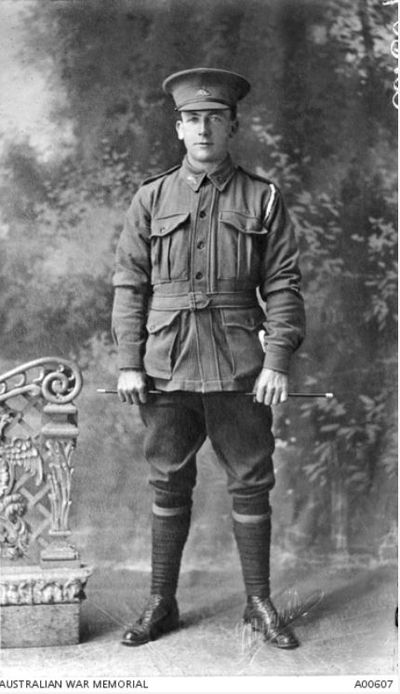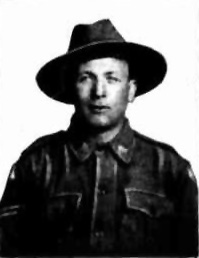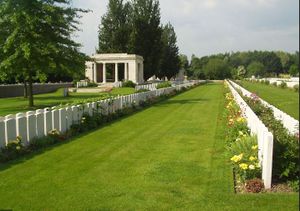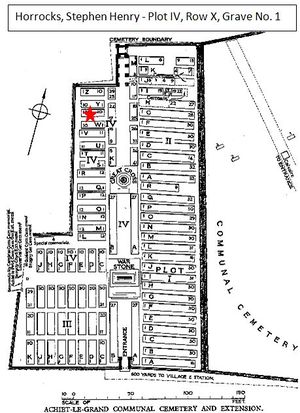Stephen Henry Horrocks
From Our Contribution
 Courtesy Australian War Memorial | |
 | |
| Personal Information | |
|---|---|
| Date of Birth |
Not known "Not known" contains an extrinsic dash or other characters that are invalid for a date interpretation. |
| Place of Birth | Wigan, Lancashire |
| Death | 2 Aug 1916 |
| Place of Death | Bapaume, France |
| Age at Enlistment | 26 years, 5 months |
| Description |
5' 5" (1.65m) tall ; 138 lbs 62.596 kg ; fair complexion ; blue eyes ; fair hair |
| Occupation | Mill hand |
| Religion | Church of England |
| Address | NOK Forrest street, Palmyra, Western Australia |
| Next of Kin | Father , Mr Henry Horrocks |
| Military Information | |
| Reg Number | 292 |
| Date of Enlistment | 2 Mar 1915 |
| Rank | Corporal |
| Unit/Formation | 28th Battalion, B Company / 7th Brigade, 2nd Division |
| Date of Embarkation | 9 Jun 1915 ‒ 30 Jun 1915 |
| Ship Embarked On | HMAT A11 Ascanius Fremantle to Port Suez |
| Fate |
Wounded in Action 29 Jul 1916 at Poziéres POW Pozieres Died from Wounds 2 Aug 1916 while a POW |
| Monument |
Armadale War Memorial (West Armadale panel) Armadale and Districts Roll of Honour Australian War Memorial The Australian Ex-Prisoners of War Memorial Ballarat, Victoria |
| Medals |
1914-15 Star British War Medal Victory Medal |
Contents
Pre War
War Service
Originally allocated to 'D 'Company of the 24th Battalion this was changed for him to become an original member of the 28th Battalion's 'B' Company, he trained at Blackboy Hill until leaving for Egypt on 9 Jun 1915.
Arriving at Port Suez on 29 Jun 1915, they anchored in the bay and didn't disembark until 2 Jul 1915 when they proceeded to Abbassia camp near Cairo by train. The battalion spent the second half of August based at the Citadel in Cairo on garrison duty prior to moving to the aerodrome camp at Heliopolis.
On 3 Sep 1915 they moved by train to Alexandria where on the next day they boarded the HMT Ivernia for Lemnos Island, and on 10 Sep 1915 they transferred to the HMT Sarnia for the journey from Mudros harbour to Anzac Cove. The battalion landed on the Gallipoli Peninsula around midnight, 10 Sep 1915.
Promoted to Temporary Corporal on 16 Sep 1915, he was evacuated 24 Oct 1915 on HMHS Rewa from Gallipoli to St Andrew's Hospital in Malta via 7th Field Ambulance and 16th Casualty Clearing Station with enteric.
Stephen returned to Alexandria via HMHS Valdivia on 21 Jan 1916, and was sent on to Heliopolis before entering 2nd Australian Auxiliary Hospital on 1 Feb 1916. Stephen was released to duty on 18 Feb 1916.
Initially identified as needing to return to Australia, he instead rejoined the 28th Battalion on 6 Mar 1916 at Ferry Post on the Suez Canal, just prior to their move to Alexandria on 15/16th March. The battalion embarked on HMAT A32 Themistocles, which departed Alexandria harbour at 5:30pm for Marseilles in southern France, arriving there at 3:30pm on 21 Mar 1915.
His promotion to Corporal was confirmed on 14 Jul 1916 as the battalion was rebuilding in a rest area after a stretch in the front line at Messines. On 29 Jul 1916, he was involved in the attack on the German OG1 and OG2 trenches on the northern edge of Pozieres, and originally it was thought that he had been Killed in Action that morning as, in addition to those whose bodies that had been found, 257 members of the battalion, including Stephen, were simply 'missing'.
Stephen's Red Cross file reports that he was captured after being wounded in the action that day, and that he died on 2 Aug 1916 of his wounds, at a Field Hospital in Villers-au-Fos, in France. He was later exhumed and reburied in a CWGC cemetery.[1].
The Unit War History entry for the day indicates the savage nature of the action in which he received his wounds:
Sausage Valley 28/7/16 6pm to 29/7/16. Battalion marched to positions of deployment for the attack on German Trenches OG1 and OG2 NORTH of POZIERES. Battalion was in position in four waves ready for the advance by 11:30pm. At 12:10am enemy opened up a heavy fire with H.E. shrapnel and Machine Guns, causing a number of casualties. Our artillery placed a heavy barrage fire on enemy trenches. As soon as theirs lifted, the men rushed forward in perfect order, and were met with heavy fire from rifles, machine guns and artillery. The first wave was held up by the enemy's wire which was intact and very strong. The four waves reached the wire and unavailing efforts were made to find openings or make them in the face of intense machine gun fire. Heavy casualties resulted. A very intense artillery barrage of the enemy's prevented any reports of the situation getting through and it was not until 2:05 am that orders for the withdrawal could be delivered. From this hour onwards the men were withdrawn and ordered to return to SAUSAGE VALLEY. Lieut Col Collett was wounded, three Company Commanders were killed, one severely wounded and 8 other officers killed or wounded. About 11am the battalion marched to TARA HILL to bivouac. 63 Killed, 151 Wounded, 257 Missing.[2]
Notes
Additional information: Buried in ACHIET_LE_GRAND COMMUNAL CEMETERY EXTENSION - Plot IV Row X, Grave 1 . Son of Henry and Mary Ann Horrocks, of Forest St., Palmyra East, Fremantle, W.A. Achiet-le-Grand is a village 19 Kms south of Arras and 4 miles North West of Bapaume in France.
Mentioned by name only, in The Drill of the Foot-Hills 1917 Feb-Mar edition.
- ↑ "Australian Red Cross Wounded and Missing Files - Stephen Henry Horrocks". Australian War Memorial. 2018. Retrieved 2 May 2018.
- ↑ 28th Battalion War Diary, July 1916

